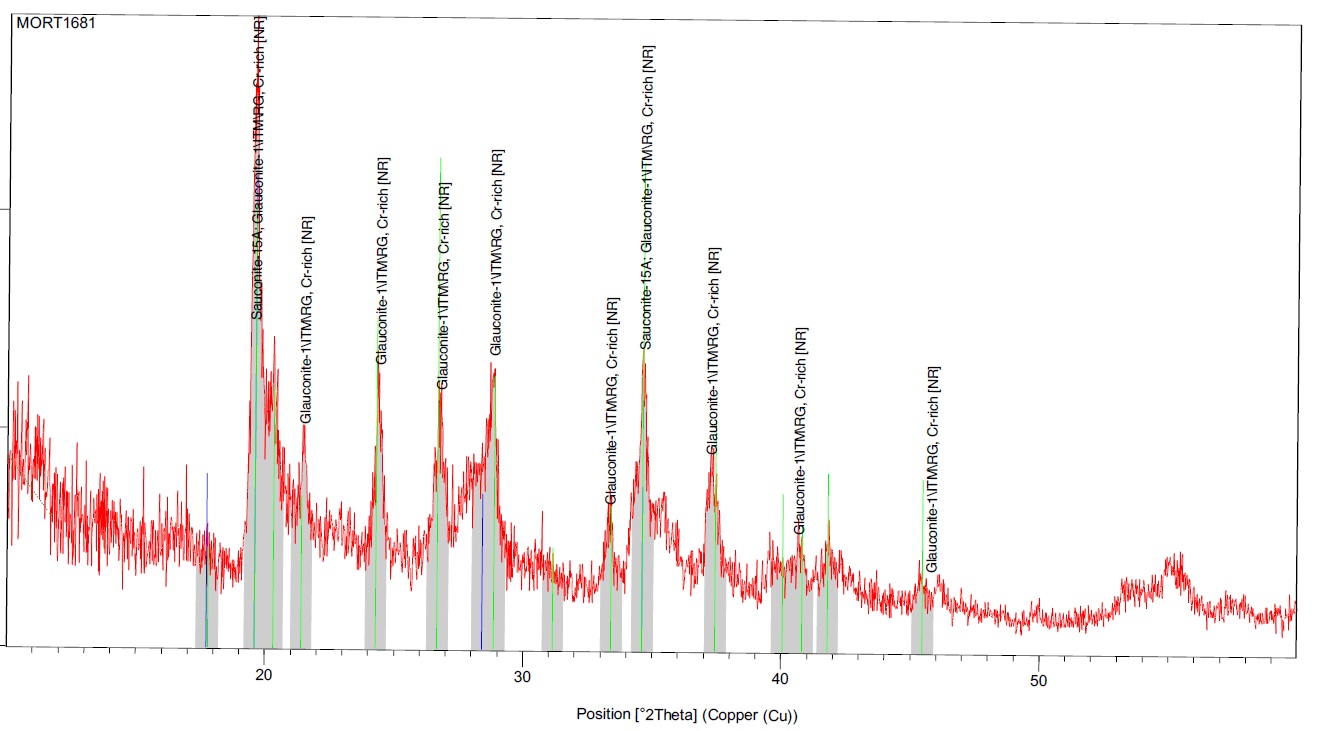Specimen data for Glauconite
Tom Mortimer catalog number: 1681
Identification method: Initial idenitifcation was visual. This species was first identified from Hurricane Mtn. by
Peter Samuelson several decades ago. It is unknown what method or resource Peter used to arrive at this identification. New
England collectors have applied the glauconite ID to this mineral for decades. It has appeared in several NH species lists in
Rocks & Minerals.
In February, 2019, I performed a polished grain, standardless, EDS analysis on a sample from this specimen, shown below.
This analysis suggests a celadonite group mineral may be a better species assignment for these specimens. Presently,
magnesium is an "essential element" for glauconite, (per mindat.org). No magnesium was detected in my analysis.
Discussion continues below this EDS plot.
 .
.
A mindat.org messageboard discussion on this glauconite analysis gave some interesting responses from knowledgeable mineralogists:
"Glauconite is essentially the K-deficient equivalent of celadonite just as illite is the K-deficient equivalent of muscovite;
as such, it's not a mineral, per se, but a compositional space within the K-deficient [celadonite/ferroceladonite/aluminoceladonite/ferroaluminoceladonite]
space, and so there can be Mg-, Fe2+-, Al-, and Fe3+-dominant varieties that I don't think are nomenclaturally differentiated."
"for practical purposes outside of laboratory settings, if the mineral occured in a sedimentary rock it was called "glauconite" and if in a volcanic rock it
was called "celadonite"."
"Most geologists and petrologists donít care much for the mineralogical definitions and ... call a green mica either glauconite or celadonite based on whether
itís in a sedimentary or igneous rock. Thus we would be reluctant to call the Hurricane Mtn material glauconite, but maybe it is."
[Tom Mortimer] The mindat.org formula (2/2019) for glauconite is (K,Na)(Mg,Fe+2,Fe+3)(Fe+3,Al)(Si,Al)4O10(OH)2
indicating Mg is essential. Webmineral.com, the RUFF database, and as near as I can determine, the IMA, give the glauconite formula as:
(K,Na)( Fe3+Al,Mg)2(Si,Al)4O10(OH)2 , suggesting that Mg is not essential.
"glauconite is not a mineral but rather a family of related minerals within a composition space bounded by several end-member minerals, just as biotite is
also not a mineral but is instead a family within a composition space."
[Tom Mortimer] Bishop et. al. in their 2008 article in Clay Minerals (March 2008, pgs. 35 - 54) include an analysis (Table 1) of a Hurricane Mtn. glauconite with a formula:
Na0.03K0.753(Ti0.003Al0.202Fe3+1.426Fe2+0.402Mg0.004)(Si3.541Al0.549)O10(OH)2 .
That is a pretty tiny bit of Mg, certainly much smaller than I can detect with the EDS instrument I am using (without averaging for an hour or so). The sample for this analysis was
provided by Carl Francis from the Harvard collection. Some new (to me) spectral analysis instruments were used in the Bishop study. Quoting from the Bishop article:
"Visible/near-infrared (VNIR) and mid-IR reflectance spectra were measured at the Reflectance Experiment Laboratory (RELAB) at Brown University, USA. Bi-directional VNIR
spectra were measured relative to Halon under ambient conditions, while biconical on-axis reflectance spectra were measured relative to a rough gold surface using a Nicolet 740, while a Nicolet Nexus
Fourier transform infrared (FTIR) spectrometer was used to measure the off-axis reflectance spectra." I [tm] find it remarkable that APFU chemistry can be determined with these techniques to three decimal places !
In February, 2019, I obtained a PXRD analysis of a sample from this #1681 specimen by John Attard. This PXRD is included below.
 .
.